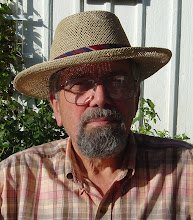
Just recently I was so powerfully affected by the beauty of the flowers in bloom in a wild meadow nearby, that I thought to myself - it's not too late, I should at long last take the time to find out some of the names of these little gems of nature. One of the loveliest was a little yellow flower, growing in great profusion and blanketing wide areas of the field. It was only when I got down on my knees for a really close look that I recognized the true wonder it offered. The flowers were borne in fat clusters about six inches long; but the individual florets were the tiniest things imaginable. Four of the smallest petals I have ever seen formed a tiny gold star, with room in the middle for just a couple of stamens, which somehow looked out of scale. There must be thousands of these florets on each cluster. The leaves of the plant were alike beautiful in their delicacy and brillian green colour. Little whorls of needlelike leaflets grew symetrically around the stem, and from the whorl another little stem would grow.
I came back to the meadow again and again. I took photos, I brought home samples of this and other plants. I went to my bookshelf and took down the long-unused Audubon Field Guide to North American Wildflowers, confidently expecting to find the flowers I sought clearly and unambiguously described and illustrated. Then I could properly title the pictures I had uploaded to 'Flickr'.
Ah, if only nature was so simple! To my astonishment, there appeared to be no flower in the manual that matched what I had. Despite diligent searching, I was reduced to calling this "Yellow Wildflower 1". I broadened my investigation. Surely, thought I, with all the millions of pictures on Flickr, someone will have illustrated my little beauty? Well yes; the pictures are indeed there, but they only come up if you already know the name, which, uh, didn't work for me at that time. Searching on "yellow, wildflower, cluster" didn't bring up a match. Not to be thwarted, I next searched for groups: two great groups for wildflowers came up on page one. And here a little serendipity came in. In the course of my search I also came upon a group called "ID Please". What a Godsend. Adherents of this group delight in the puzzle of identification, and within 24 hours of posting a photo of my treasure to the group I had my answer. The flower is called "Lady's Bedstraw" or 'Galium verum' to use its official moniker.
Or is it? It turns out there are possibly hundreds of species of 'Galium', and scores of Bedstraws within the group. I Googled. I Wikipeded. I have examined as many species as I can find, and there seem to be no similar candidates. Why take all this trouble? Because the yellow Lady's Bedstraw is apparently not supposed to live in Canada. It is European. It does not feature in the ROM Field Guide to Wildflowers of Ontario, which I have just taken out from the library.
Which raises the question - is this in fact the European flower, brought accidentally or intentionally to Canada? Or is it some rare variety too uncommon to have been included in the standard texts? I rather lean to the first option. Especially as this field is right next to Fort George, one of the first places in the area inhabited by Europeans. Did they bring mattresses? Did they shake out the old stuffing and unwittingly liberate seeds here. Or did some thoughtful immigrant carefully gather some seeds to bring, thinking not only how useful this plant would be, but how comforting it might be to have this reminder of home?
Where was I? Oh yes, put a name on a flower. Done that.

No comments:
Post a Comment